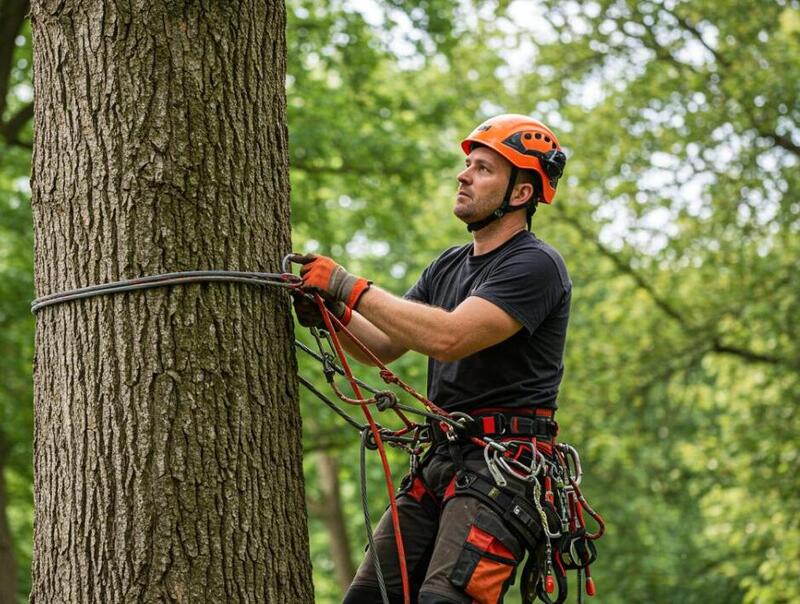
Every landscaper knows healthy, grown-up trees are key for any outdoor area, but few see how important guying is for keeping them steady. Strong winds can do a lot of damage, so knowing how to support trees well is now very important. This guide explains the basic guying skills every landscaper should know. It will help protect big trees and make for a healthier world.
Why is guying essential for tree stability?
Guying is a technique used to support trees, primarily while they establish their roots after planting or when they face environmental stresses. Unlike staking, which is suitable for saplings, guying provides support to larger trees that may lean or suffer from wind damage. By leveraging anchors and wires, landscapers can maintain a tree’s vertical alignment, ensuring it thrives in its environment.
The process of guying is not just about securing a tree. It involves several elements that together foster healthy growth. To master guying, landscapers must comprehend the materials involved, the procedure, and the necessity of timing when implementing this technique.
Materials needed for guying include:
-
Metal anchors or wooden stakes
-
Durable wires
-
Burlap, canvas, or rubber strapping
-
Mallet or driving device
These elements will provide the necessary support for your tree without causing harm.
Steps to successfully guy a tree
Proper guying helps trees stay stable and grow healthier over time. When a tree has strong support, its roots can grow better. It can also handle wind and other weather problems more easily.
Following a structured approach can make all the difference in successful tree guying. Here is how you can effectively guy a tree:
-
Space the anchors evenly around the tree, driving them deep into the soil.
-
Ensure one anchor faces upwind if stabilizing a tree previously disturbed by wind.
-
Loosely attach canvas or other material to the tree above the lowest branches to foster flexibility.
-
Connect the wires to the anchors, ensuring they do not touch the tree to prevent damage.
After one growing season, the tree should have developed strong roots, allowing for the removal of the guying apparatus.
When to use guying techniques?
Timing is key when guying trees. Intervening at the right moment makes the technique more effective and helps keep your trees healthy.

Identifying need for guying
Two specific signs indicate that guying is essential:
-
Tree trunk leaning or exposed roots due to wind damage: If a tree trunk leans noticeably, especially with roots showing, it likely means wind has made the tree unstable. This shows the roots aren’t holding the tree firmly against the usual wind or strong gusts. Without support like guying, the lean can get worse. This could cause the tree to fall, damage nearby things, or hurt someone.
-
Mature trees recently transplanted and require additional support: Moving big trees hurts their established roots, making it much harder for them to get water and stay firmly in place. While the tree uses its energy to grow new roots, it’s very likely to be blown over or moved by the wind. Supporting newly moved big trees with ropes or wires is important temporary help. This keeps the trunk still and reduces stress on the new roots as they grow. This steadiness lets the roots grow better in the new ground, improving the chances the tree will live and stay healthy for a long time.
Guying vs. staking: what are the differences?
While both staking and guying provide support to trees, they differ significantly in application.
Staking is primarily aimed at young saplings needing immediate stability, whereas guying targets larger, more established trees. It’s essential for arborists to know these differences to use the most effective technique for each tree’s circumstances.
|
Technique |
Best for |
Materials used |
|---|---|---|
|
Staking |
Young saplings |
High stakes, wire |
|
Installed immediately after transplanting |
Wooden stakes, cables |
|
|
Guying |
Mature trees |
Anchors, flex wires |
|
After wind damage conditions |
Metal anchors, strapping |
Mastering essential tree guying skills can significantly impact your landscaping endeavors. With an understanding of when and how to apply these techniques, landscapers can offer enhanced tree care that fosters healthier, more resilient trees. Always prioritize safety and quality care as you nurture the greenery surrounding us.
Engaging professional tree care can elevate your guying techniques and tree care practices. Certified arborists contribute expertise that extends to regular inspections and tailored care plans. Their insights can help identify potential hazards and improve overall tree stability.











